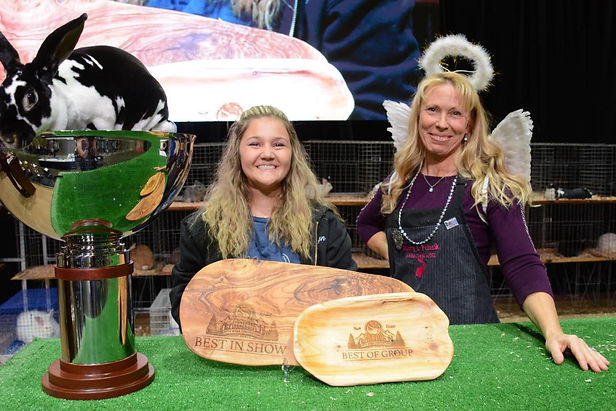
RABBIT CLUB
Kaitlyn Battson Best in Show Youth 2022 ARBA Convention

Rex Varieties

This group picture was taken at the annual PA Show/picnic. This particular year, the group had entries from every single variety. Not something that happens very often in local, non-national shows.
A Sight to See
Rex are known as the "King of Rabbits" because of their unique fur structure. Before this mutation appeared, the rabbit world had seen nothing like it! When the first animals were presented to the abbot Amde Gillet - priest of the village Coulonge in the South of France, the abbot declared these specimens, "The King's rabbits", the Latin word for king, being rex. The first color or variety to be perfected was the Castor (which means 'beaver' in Latin from the original Greek - kaster). In fact, the breed itself was first dubbed "Castorrex". Though the first specimens of this breed were lacking in many areas (health, body structure, etc.), US breeders set about breeding for improvement as well as developing new varieties after the breed first came to the States around 1924. As a result, 'Castor' was dropped from the breed's name, giving it the new moniker of 'Rex'.
The beautiful Castor variety has remained a staple in this breed's make-up. The variety was so named because of its resemblance to the pelt of a beaver - a once highly sought after fur in the USA and abroad. At present the Rex boasts 16 varieties. Amber is the newest of the 16, being officially accepted by the American Rabbit Breeders Assoc., Inc. in October of 2007. Prior to the Amber Rex's acceptance, the Black Otter variety (arguably one of the most striking of all Rex varieties) was accepted in 1988. Otter became an official 'group' with the acceptance of Blue, Chocolate, and Lilac Otter varieties in fall of 2008 - becoming eligible to officially show in February 2009.
Below are representative photos of each of the 16 varieties. Please refer to the latest edition of the NRRC Official Guidebook for detailed articles on each variety. Not a member? Now is the perfect opportunity to join the NRRC!
















* Note: Broken and Otter Rex are each shown as a group. Broken includes all recognized color varieties in conjunction with white or white in conjunction with two colors (Tri-Color); those accepted colors being: dense Black and Golden Orange; Lavender Blue and Golden Fawn; dark Chocolate Brown and Golden Orange; Dove Gray and Golden Fawn. Eye color corresponds to solid variety. All varieties are judged together.
Otter Rex includes 4 varieties: Black, Blue, Chocolate, and Lilac. Pattern on Blacks and Chocolates to be pale cream on belly, underside of chin and tail. Belly is divided from body color by a distinct border of Tan. Nostrils and Triangle to be Tan. Eye circles and inside of ears are Fawn. Chest is an even mixture of Tan and the body color, merging into the body color. Pattern on Blues and Lilacs to be pale cream on belly, underside of chin and tail. Belly is divided from body color by a distinct border of Fawn. Nostrils and Triangle to be Fawn. Eye circles and inside of ears are pale cream. Chest is an even mixture of Fawn and the body color, merging into the body color. All varieties are judged together.